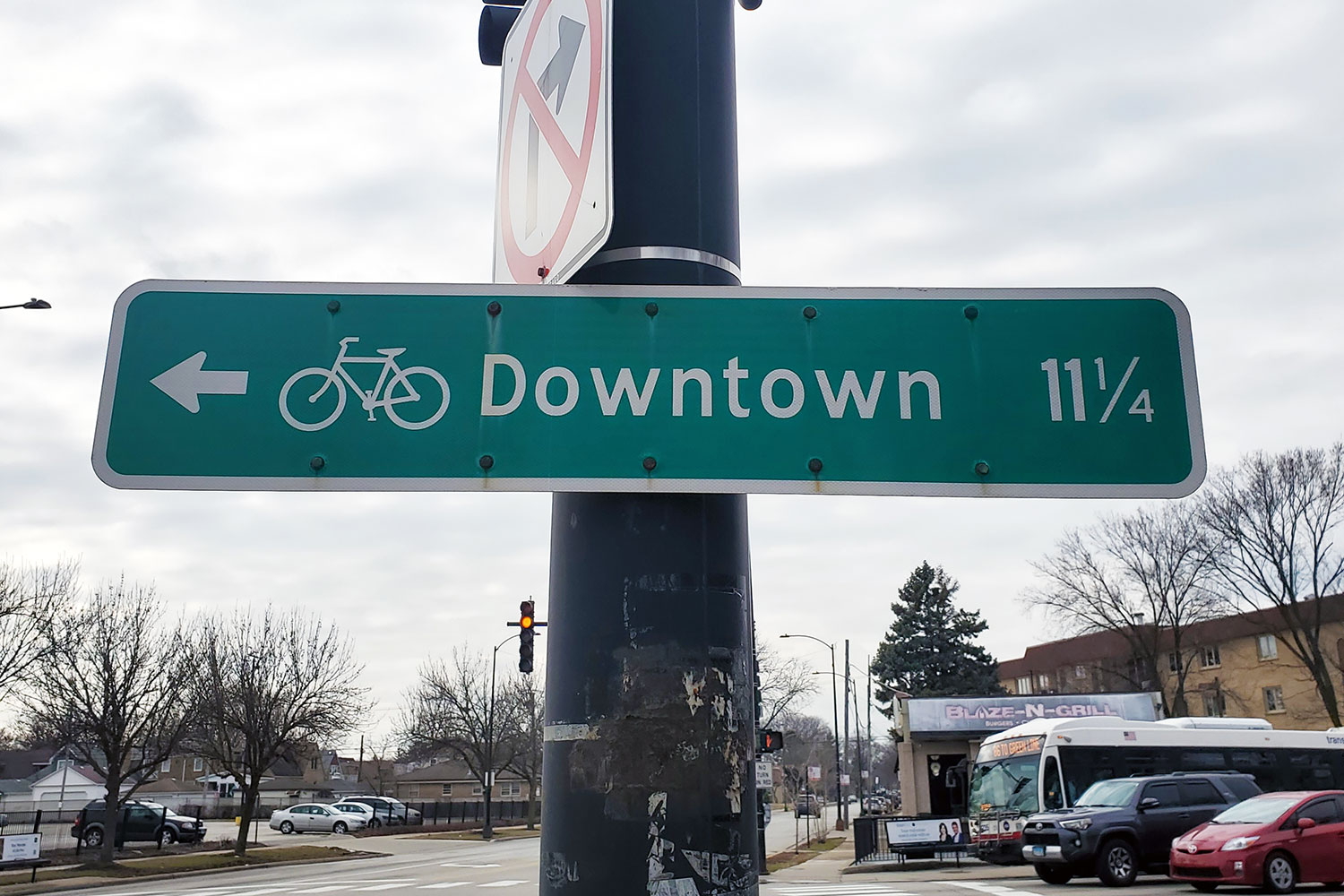Milwaukee Avenue is, according to the city’s Department of Transportation, “Chicago’s busiest bikeway” — on a typical day, 2,736 cyclists pedal past the intersection with Elston Avenue. As a diagonal street, it offers a quick route into downtown, and it passes through the city’s most progressive neighborhoods — Avondale, Logan Square, Wicker Park — which are populated by artists and non-profiteers who believe the automobile is not healthy for children and other living things. Or who just can’t afford cars.
As the city’s busiest bikeway, though, Milwaukee is also the deadliest, site of more car-bicycle collisions than any street in Chicago. Between 2020 and 2022, 50 cyclists were hit by cars there. Three were killed. Their deaths are memorialized by “ghost bikes” — flower-covered, frames chained by the roadside.
Because it is so heavily traveled, and so dangerous, CDOT has established a network of bike lanes along Milwaukee’s entire length. On the Far Northwest Side, beginning in Gladstone Park, the lanes are either dedicated or shared, painted on the street. Closer in, from Logan Square to downtown, the lanes are protected, with plastic bollards or brand-new, curb-height concrete barriers. Some cycling advocates say it’s still not enough to keep them safe.
“I myself avoid Milwaukee Avenue like the plague,” said Christina Whitehouse of Bike Lane Uprising, a cycling safety group. “It’s dangerous. The reality is, we don’t have consistent lanes on Milwaukee, because of businesses that push back. So many concessions have been made that the design is piecemeal. It gets damaged and it’s not maintained.”
A week ago Monday, after the morning rainstorms blew away and the sky turned blue again, I cycled the entire length of Milwaukee Avenue, from Devon to Kinzie — or Superdawg to Blommer Chocolate Company, if you want to go by landmarks — to see firsthand how much protection it offers a cyclist. To set the tone for my trip, I set down my kickstand in the parking lot of Superdawg and ordered a strawberry ice cream cone through the speaker. I wanted to be treated just like a driver in an automobile. The carhop delivered the cone while I sat on my bicycle, becoming, for that order, a bikehop.
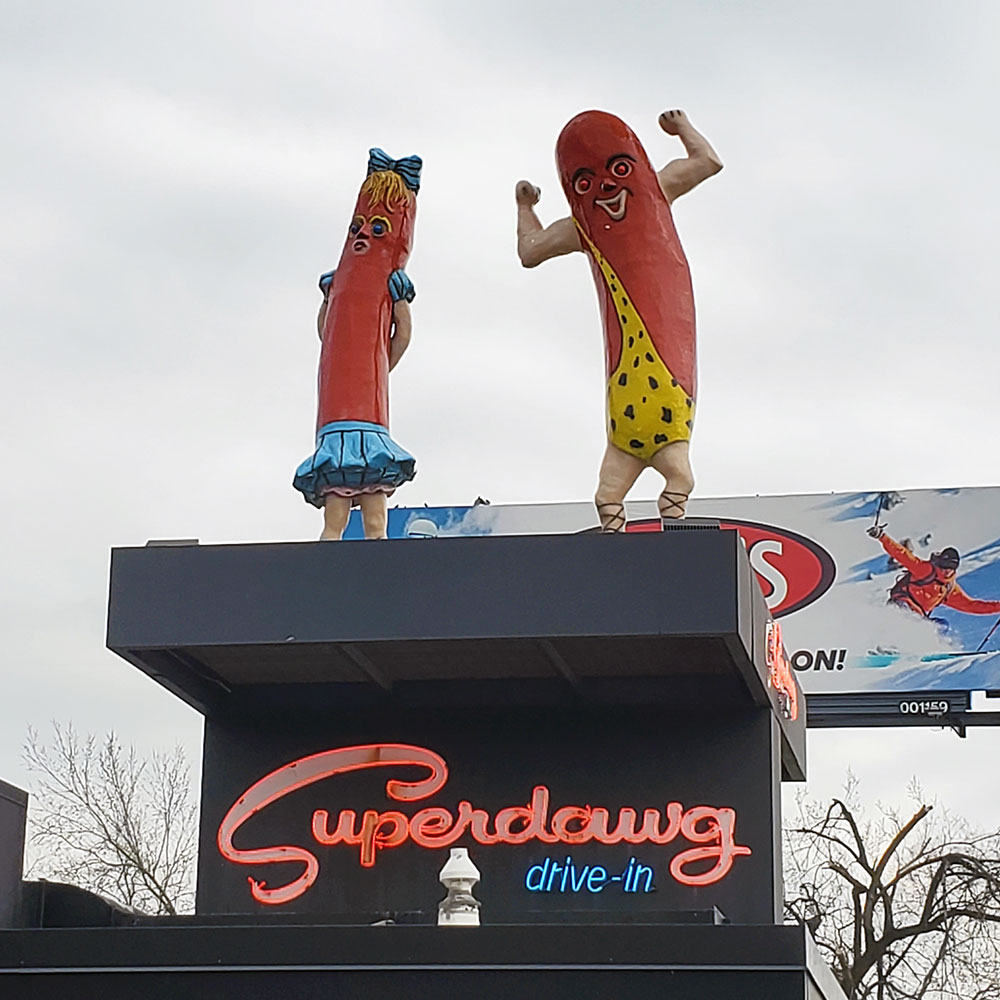
In that remote part of the city, Milwaukee is a broad, four-lane thoroughfare, like Northwest Highway — broad enough for what CDOT calls a “buffered bike lane” on both sides of street — painted stripes delineating the zones for cars and bicycles. Once the street crosses under the Metra tracks in Jefferson Park, though, it narrows, and suddenly, cyclists have to settle for a “shared lane,” a bicycle symbol with two arrows that lets motorists know the lane belongs to bikes, too. Motorists drive right over it. Around Wilson Park, a narrow, striped lane appeared. I wasn’t sure if this was supposed to be a bike lane, but it was wide enough for a wheel, so I pedaled inside it, keeping alert to cars on my left.
The most dangerous intersection on this dangerous street is at Kilbourn Avenue, in Old Irving Park, where two of the three recent fatalities occurred. On May 4, 2022, Nick Parlingayan was struck and dragged to his death by a driver who, his family alleges, was forced into the bike lane by the reconstruction of the Grayland Metra station. In November 2019, Carla Aiello was crushed beneath the wheels of a dump truck. Their ghost bikes face each other across the street. The sites of both crashes are protected by bollards — the first bollards I’ve seen on my ride — but that’s far from the protected lane the city’s bike lane map advertises between Irving Park Road and Addison Street. (There are concrete barriers near Schurz High School.)
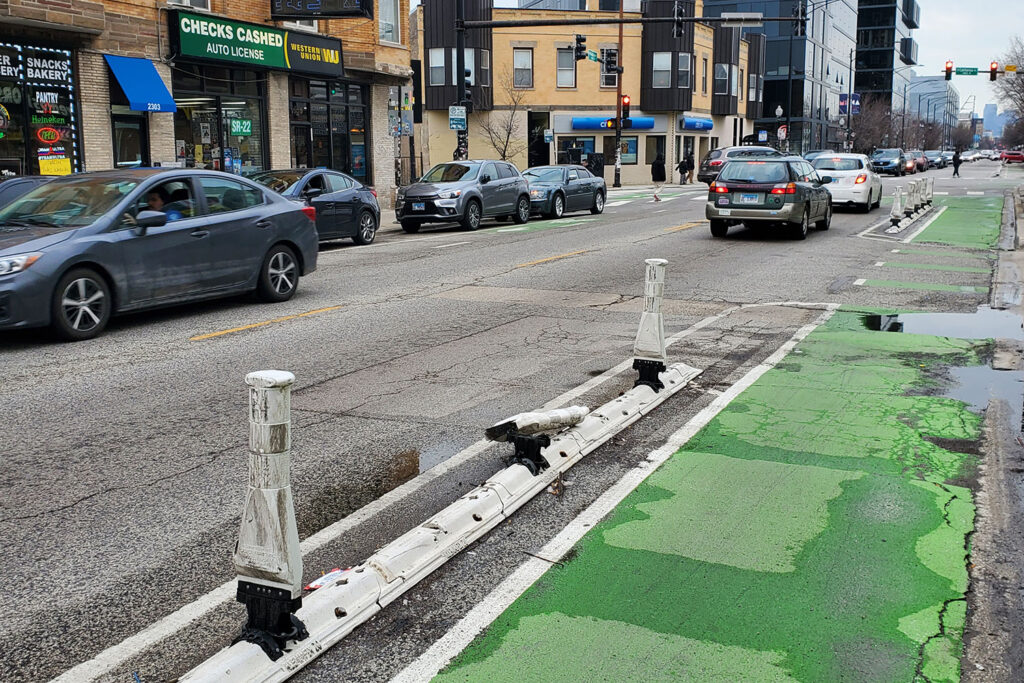
Because Milwaukee is a well-cycled street, it has a robust cycling culture. In Avondale, I stop at Kozy’s Cyclery, the most well-stocked bicycle emporium I’ve ever seen, with a thousand bikes on three floors, from a $419 Retrospec cruiser to a $14,000 Specialized e-bike. The COVID pandemic put a lot of people on bicycles, said manager Luis Iniguez, who has worked at the store for 27 years. Better bicycle infrastructure will encourage even more to ride.
“It’s doing better, but it can be better,” Iniguez said. “If they feel safe, more people will cycle.”
Between Belden Avenue and California Street, I am finally funneled into a protected lane, although some of the bollards have been flattened by cars, which is why cyclists dismiss the plastic barriers as “vertical paint.” The lane runs until Western Avenue. Along this protected stretch, I stop for a beer at Revolution Brewing, a bike-friendly brewpub with a bike corral — two racks in the street out front — installed when the bar opened in 2010.
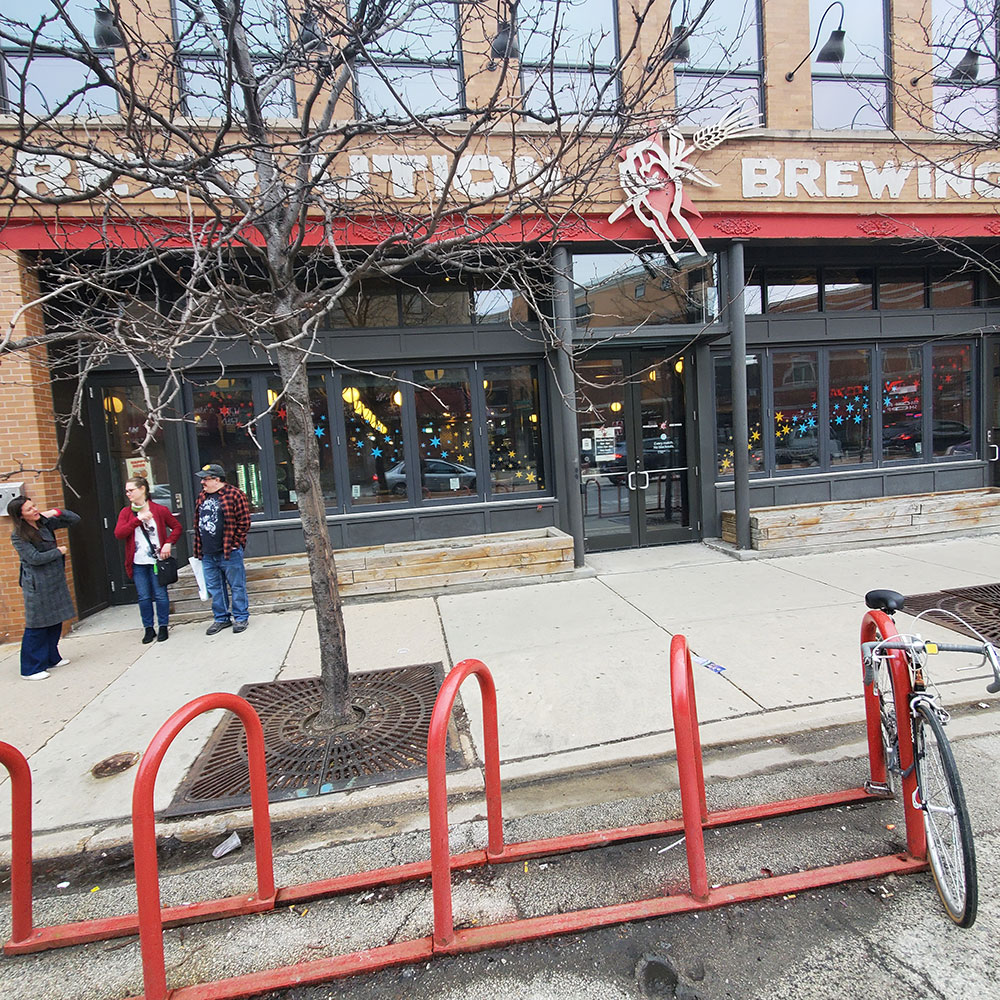
“We were one of the first people to have those,” owner Josh Deth told me. “Back in the day, we pioneered that. I used to run Handlebar. It’s a couple blocks west of Milwaukee on North Avenue, so I know firsthand the bike scene. It’s a great street for biking. There is no north-south street to get downtown. Milwaukee will always be the biking street. Logan Square, Wicker Park, Humboldt Park, those are biking neighborhoods, and the Bloomingdale Trail has become a ‘node’ in a way. My friend Kevin opened a bike shop on Milwaukee, Boulevard Bikes.”
I missed Boulevard Bikes, but I inflated my tires at a pump on the sidewalk in front of The Bike Lane. According to manager Eric Tan, I was seeing so many bike shops, bike racks and protected lanes because I was inside the Bike Commuting Zone.
“Anything with 3000 North, West, South is very, very comfortable,” he said. “The continuous bike lanes make it easier. Streets like Milwaukee being protected give people comfort in riding. It helps transplants who just moved to the city. We do see a lot of commuters, in the evening, coming off work.”
According to CDOT, since the protected lane between California and Western was installed in 2020, crashes involving cars, bikes, and/or pedestrians have been reduced 56 percent. However, the protected lane ends at Western Avenue, and does not resume again until Division Street, three quarters of a mile down the road. Here begin the concrete barriers the city has promised to replace bollards with by the end of the year, although they don’t offer as much protection as I’d anticipated: I was expecting jersey barriers, but these are curb height, a little higher than my ankle. For the rest of the ride downtown, I see a mix of bollards and concrete. (Jersey barriers, according to CDOT, “can create accessibility issues for pedestrians and people with disabilities.”)
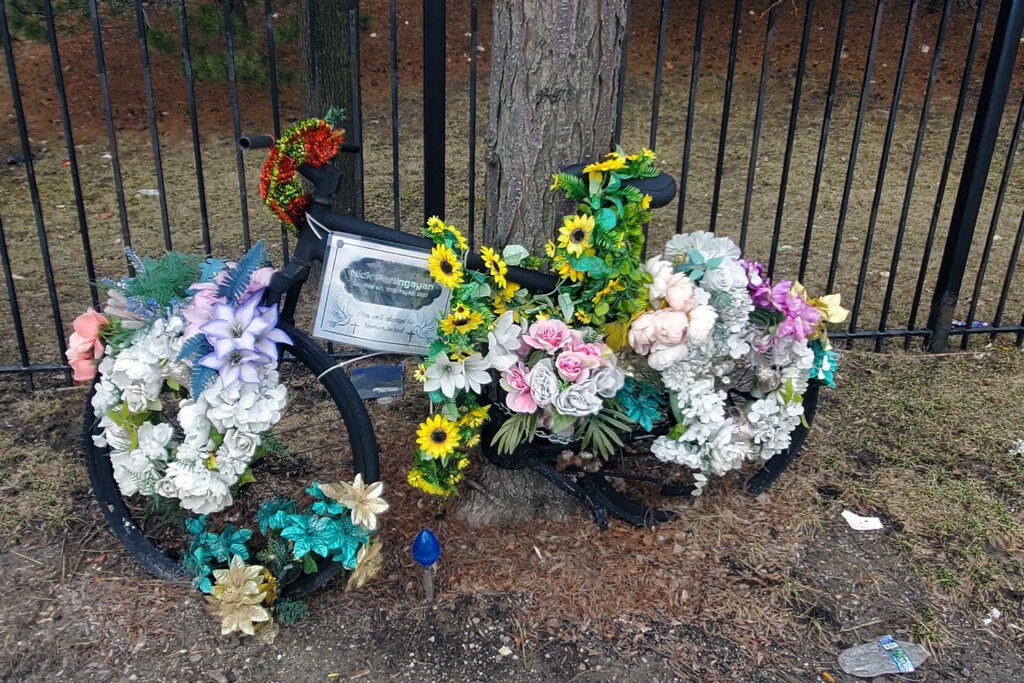
“Jersey barriers actually force people not to drive into the bike lane,” said Whitehouse, of Bike Lane Uprising. “People can drive over these concrete barriers; they’re ineffective, but they’re better than nothing.”
As Whitehouse had told me, protections for cyclists on Milwaukee are “piecemeal.” CDOT is always working on it, though, with more plans for cycling infrastructure on Milwaukee than any other street: protected lanes between Addison and Waveland, Augusta and Division, Chicago and Elston, and Hubbard and Ohio, plus concrete upgrades between Waveland and Irving Park and Kinzie and Hubbard. By the end of the year, three of Milwaukee’s 11¼ miles are scheduled to be protected by concrete barriers.
“Later this year, CDOT will begin reconstructing North Milwaukee Avenue from Logan Square to Belmont, which will feature new bike lanes, curb extensions, raised crosswalks, increased pedestrian plaza space, and a reconfiguration of Logan Square to provide protected off-street bicycle paths around the Square,” CDOT Director of Public Information Erica Schroeder said in an email.
“People are going to side streets and completely avoiding it,” Whitehouse said. “There’s a lot of people avoiding these spaces with cars. I completely avoid a lot of these ‘bike-friendly’ areas because it’s a facade.”
After 11¼ miles, I can report that no matter how many improvements CDOT installs, Milwaukee Avenue will never be the most relaxing ride in Chicago: it’s narrow, and it’s congested, because cars find it just as convenient as bikes. Cyclists who don’t want to share a street with cars will always have to ride elsewhere.
Related Content



